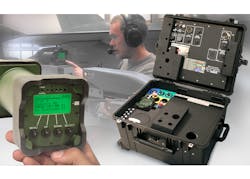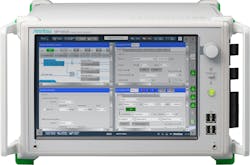By Jamie Whitney
There are no do-overs in life, and warfighters must have confidence that their equipment will work as intended the first time. On top of this requirement for rock-solid systems, warfighters need their technology to be ready at a moment's notice. To ensure everything is ready, test and measurement equipment is invaluable.
Retired U.S. Air Force Maj. Gen. Stephen Sargeant, who is the CEO of Marvin Test Solutions in Irvine, Calif. says his company shines in assuring arms are tested and mission ready.
"In military-aerospace, mission readiness is key, and readiness requires comprehensive, accurate testing of the complex systems that warfighters rely on to accomplish their objective the first time," Sargeant says. "With lives on the line, maintainers must have the resources to deliver an aircraft that is completely checked out and fully mission capable. The risk of failure is too high, and the consequences of failure are too great, to rely on even educated guesswork when itOne representative challenge for test and measurement equipment involves complicated precision-guided munitions of the U.S. military.
In 1975, the U.S. Department of Defense (DOD) Long Range Research and Development Planning Program (LRRDPP) and, a year later, a defense science board study, opined that the United States should pursue precision guided munitions as a matter of policy.
When Operation Desert Storm began in 1990, the American people at home and warfighters on the ground got a look at just what precision-guided munitions were capable of and the DOD never looked back.
"Precision-guided munitions have become the weapons of choice for militaries around the world. For those weapons to be truly reliable -- to ensure that a missile fires every time when it’s supposed to, and never when it’s not supposed to -- the test sets must be up to the challenge," says Marvin Test's Sargeant. "And given the increasing complexity of these mission-critical systems, the need for comprehensive accurate testing becomes more acute. For example, the emerging concept of collaborative combat aircraft requires a team of aircraft, both crewed and uncrewed, working together to accomplish a mission. Every element of this complex and dynamic system of systems must be fully capable of reliable communications and successful weapons employment."
Harsh environments
Precision-guided munitions and other sensitive military equipment often are expected to perform flawlessly in challenging conditions including at supersonic speeds in extreme temperatures. In that end, Reyes Cortes, who is the manager of electrical testing for Dayton T. Brown in Bohemia, N.Y. explains how accurate test and measurement equipment helps achieve mission success.
"The products we test need to survive in very harsh environments," says Dayton T. Brown's Cortes. "When testing for space, electronic components and systemsCortes continues, "Having the right equipment that is properly calibrated is a critical step. Combining the right tools with MIL STD specifications leads to success. There have been clients’ products that pass during internal testing but then fail during our independent testing. We review the test plan and setup procedures as well as the calibration data of the equipment used during test to discover this critical step was missed during their internal testing."
Rodger Hosking, co-founder of Pentek and now a vice president at Mercury Systems in Upper Saddle River, N.J., explains that because defense equipment is largely reliant on real-time signal processing, the testing process is essential to ensure everything is ready and reliable in the extreme environments they're expected to operate in.
"Using these devices to test these systems is essential for many critical reasons," Hosking says of real-time signal processing reliant systems. "Protecting a pilot in a fighter jet during combat requires effective electronic countermeasures that must precisely and instantly deceive enemy equipment or help evade enemy fire. For targeting and fire control systems, accuracy of determining target position, speed and trajectory assures hitting targets and minimizing collateral damage."
Hosking continues, "For SIGINT systems, detecting and extracting information from small signals in the presence of noise and interference can help warfighters improve the effectiveness of offensive and defensive measures. All these systems must be precisely characterized with test and measurement equipment under a wide range of situations using complex simulations and challenging scenarios, and then rigorously tested during production to ensure consistent and reliable operation over time."
To the core
Part of making sure that sensitive equipment works in harsh environments every time it is called into action, experts need to be able to inspect the disparate components that make up today's technologies to ensure each link in the chain is reliable.
Sargeant says the overall technological trends of size, ease of use, rugged, and easy to deploy is enabled by accurate test equipment.
"Test equipment commonality streamlines maintenance and sustainment, providing the capability to support multiple aircraft platforms or even an entire fleet with a smaller number of test sets and fewer personnel," says the Marvin Test Solutions CEO. "As we worked with maintainers in the field and learned about the kinds of test sets that would make them more effective, we designed those desired features into our test sets. And it turns out that maintainers were pretty smart about the characteristics of the test sets they would need to achieve their objectives."
Trends in test
Marvin Test's Sargeant says the U.S. Air Force has adopted the mantra of Chief of Staff of the Air Force Gen. Charles Q, Brown, Jr. to "Accelerate Change or Lose" and recently has released an operational concept called "Agile Combat Employment (ACE)", which calls for smaller, tailorable force packages and multi-capable airmen.
"ACE puts a premium on easy to use, easy to sustain, easy to deploy, high-performance, small footprint, and rapid test time equipment," Sargeant explains. "Our rugged, portable flightline test sets represent real-world solutions, available today, to help the services successfully execute the ACE operational concept. So, we’re not driving the trends, but in some ways we’ve been ahead of the curve."
Dayton T. Brown's Cortes says he and his company are seeing a lot of demand for services in the electric propulsion sector.
"We see growing demand for engineering, test, and technical services in electric propulsion and power storage within the space, aerospace, and transportation industries as companies strive to achieve carbon neutrality by 2050," Cortes explains. "We’re doing a lot of battery testing for example for electric vehicles -- cars, buses, ships, as well as ground equipment for aerospace applications. It’s estimated that 30% of emissions come from aerospace ground equipment. Additionally, we’re seeing a growing demand for testing for space including satellites, cubesats, and lunar landers. We perform several types of testing including environmental, shock and vibration, and acoustic."
Mercury's Hosking says that his company's customers have expressed a need to generate challenging test signals to signals to verify proper operation of the most advanced electronic equipment. "This means RF signals with higher frequencies and wider bandwidths," Hosking informs. "They also want to be able to verify that signals generated by these defense systems meet their specifications, like high power outgoing radar pulse waveforms, for example. Receive and transmit signals are increasingly sophisticated with new complex modulation and frequency hopping schemes to avoid detection, decoding or decryption.
He continues, "We design and manufacture software radio products that acquire and generate RF signals across a wide range of frequencies and bandwidths. These products rely on powerful FPGAs and processors to handle the complex real-time digital signal processing."
In the field
Hosking says that Mercury's recently introduced model 5560 3U VPX Xilinx Versal HBM adaptive compute acceleration platform (ACAP) processor, which was recently introduced, is ideal for spectrum processing applications.
"Incorporating powerful Versal FPGA fabric, advanced scalar and vector processors, on-chip high-bandwidth memory, the ACAP easily adapts to a diverse range of compute-intensive signal processing tasks, ideal for the challenging signals found in the latest defense systems," Hosking says.
The model 5560 offers 16 gigabytes of Versal high-bandwidth memory, which delivers memory bandwidth as quickly as 820 gigabytes per second. This is eight times the bandwidth of DDR5 memory at 63 percent lower power consumption.
"We also offer RF signal recorders and generators capable of capturing live RF signals in the field, such as in a UAV flying over an area of conflict," Hosking says.Last summer Tektronix in Beaverton, Ore., unveiled its 2 Series Mixed Signal Oscilloscope (MSO) that can go from the bench to the field and back. It offers benchtop performance and the Tektronix user interface. Weighing less than four pounds and 1.5 inches thin, the 2 Series MSO can fit into a small backpack. The built-in capabilities of the optional arbitrary function generator (AFG), pattern generator, voltmeter and frequency counter enable versatility built into one "Our team worked closely with engineers to deeply understand their unique needs. We cannot wait to see how the 2 Series MSO improves the way our customers work," Tami Newcombe, Tektronix President says.
Natively integrated software tools enable engineers to collaborate, troubleshoot, and debug designs across time zones. The 2 Series MSO includes TekDrive, a test and measurement data workspace in the cloud where engineers can upload, store, organize, and share any file from a connected device. Users can also perform analysis on a waveform and save it back to the cloud for immediate viewing and feedback from peers.
The Marvin Test Solutions MTS-3060A SmartCan is an example of the Air Force's ACE concept as it embraces the call for ease of use, a small footprint, ruggedness, cyber security, and deployability, Sargeant says.
"It is capable of testing all legacy and Smart weapon systems on any fighter aircraft, enabling multi-capable Airmen to ensure the highest levels of readiness for sortie generation. The SmartCan is globally deployed and supports testing of JDAM, SDB, AIM-9, AIM-120, AGM-65, and AGM-114 for F-35, F-22, F/A-18, F-16, F-15, TA-50, FA-50, F-5, Hawk, RPA and more. It uses weapons emulation and active testing methodologies to comprehensively test launchers, pylons, bomb racks, and their associated interfaces and subassemblies -- all in a handheld package that weighs about four pounds. The Air National Guard has acquired the SmartCan to support flightline armament test for their F-15, F-16, and A-10 aircraft and will soon begin using them. The intuitive operation of the SmartCan enables readiness for the service that is 'Always Ready. Always There.'
Sargeant continues, "Additionally, the SmartCan was recently awarded Support Equipment Requirements Document (SERD) certification for F-16 armament test, signifying that the SmartCan is safe, operable, and effective for testing F-16 armament systems including launchers, bomb racks, pylons, fuel tanks, and the gun. Lockheed Martin certified the SmartCan in support of one of its Foreign Military Sales (FMS) customers. The F-16 System Program Office (SPO) also declared that the SmartCan O-Level Armament Test Set is a fully qualified and approved solution for the F-16 Fighting Falcon and assigned SERD #75A77."
Last month, Anritsu in Morgan Hill, Calif., announced that its Signal Quality Analyzer-R MP1900A now supports the PCI Express 6.0 Base Specification Receiver Test and has been further enhanced with an SKP function to filter SKP packets to support separate clock architecture (SRNS). As a result, one MP1900A supports PCI Express 3.0 to PCI Express 6.0 and can calibrate stressed test signals and measure jitter tolerance using a real-time oscilloscope to provide engineers with an efficient solution to verify their high-speed interconnect designs for 5G data centers and services.
The Signal Quality Analyzer-R MP1900A is a high-performance bit error ratio tester (BERT) for testing high-speed computing and data communications interfaces, including PCI Express, USB, Thunderbolt, and 400/800 Gigabit Ethernet. Link training status state machine (LTSSM) functions are supported by a level PAM4/NRZ PPG for waveforms, high-sensitivity input ED, high-accuracy jitter generation source (SJ, RJ, SSC, BUJ), and vertical noise generation source (CM-I/DM-I and white noise), facilitating various applications, including compliance and margin tests, as well as troubleshooting.
Who's who in test and measurement
Abaco Systems
Huntsville, Ala.
www.abaco.com
Anritsu
www.anritsu.com/en-us/
Morgan Hill, Calif.
Astronics Corp.
East Aurora, N.Y.
www.astronics.com
Behlman Electronics
Hauppauge, N.Y.
www.behlman.com
Bloomy Controls
www.bloomy.com
South Windsor, Conn.
Curtiss-Wright Defense Solutions
Ashburn, Va.
www.curtisswrightds.com
Data Device Corp. (DDC)
Bohemia, N.Y.
www.ddc-web.com
Dayton T. Brown, Inc.
Bohemia, N.Y.
www.dtb.com
Diversified Technical Systems Inc. (DTS)
Seal Beach, Calif.
www.dtsweb.com
Great River Technologies
Albuquerque, N.M.
www.greatrivertech.com
Kaman Precision Products
Middletown, Conn.
www.kamansensors.com
Keysight Technologies
Santa Rosa, Calif.
www.keysight.com
Marvin Test Solutions
Irvine, Calif.
www.marvintest.com
Meggitt Sensing Systems
Irvine, Calif.
Mercury Systems
Andover, Mass.
www.mrcy.com
North Atlantic Industries
Bohemia, N.Y.
www.naii.com
Rohde & Schwarz
Columbia, Md.
www.rohde-schwarz.com
Saelig Co. Ltd.
Fairport, N.Y.
www.saelig.com
Tektronix
Beaverton, Ore.
www.tek.com
VIAVI Solutions Inc.
San Jose, Calif.
www.viavisolutions.com
Vishay Precision Group
Malvern, Pa.
www.vpgsensors.com
About the Author
Jamie Whitney
Senior Editor
Jamie Whitney joined the staff of Military & Aerospace Electronics in 2018 and oversees editorial content and produces news and features for Military & Aerospace Electronics, attends industry events, produces Webcasts, and oversees print production of Military & Aerospace Electronics.




